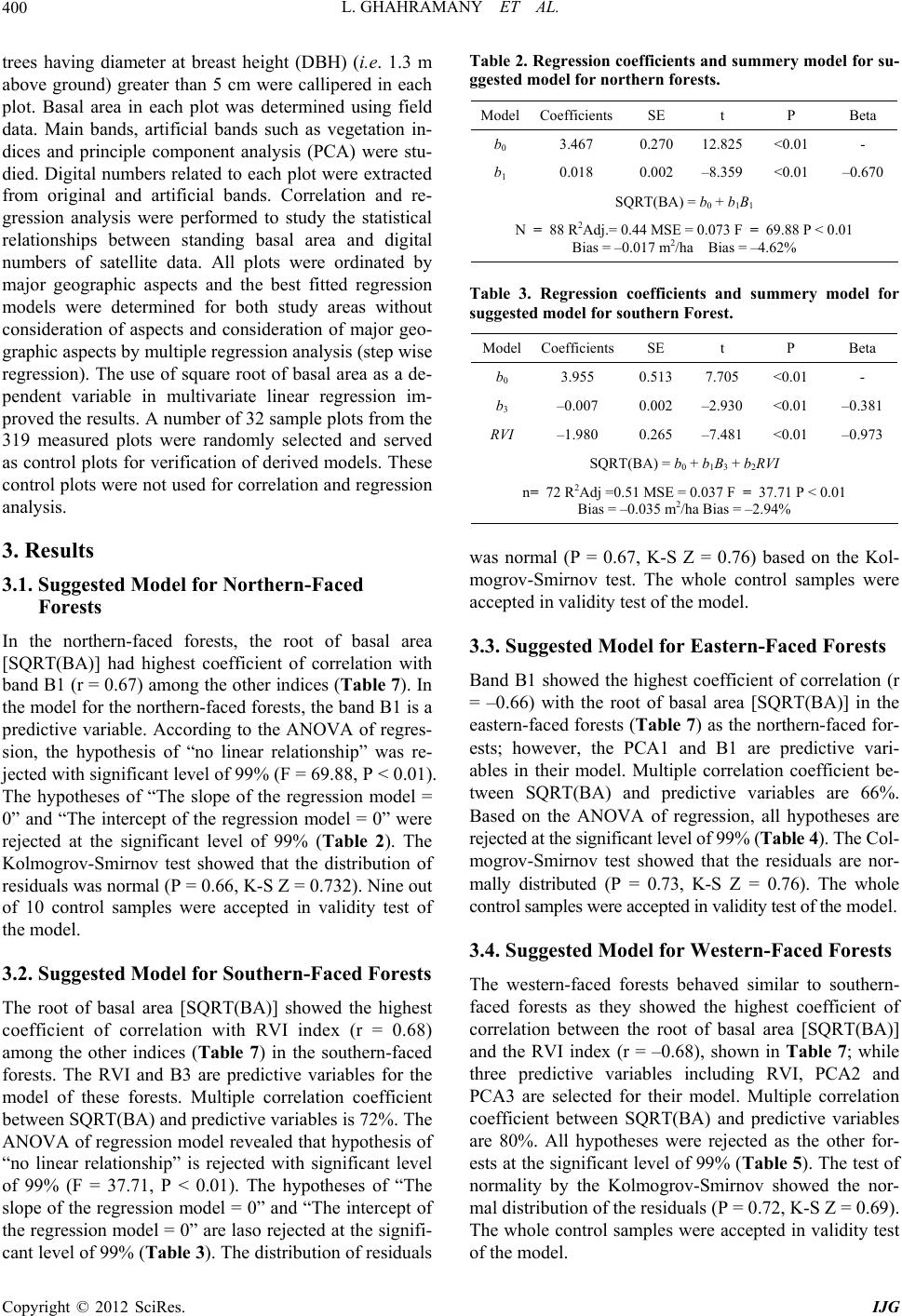
L. GHAHRAMANY ET AL.
400
trees having diameter at breast height (DBH) (i.e. 1.3 m
above ground) greater than 5 cm were callipered in each
plot. Basal area in each plot was determined using field
data. Main bands, artificial bands such as vegetation in-
dices and principle component analysis (PCA) were stu-
died. Digital numbers related to each plot were extracted
from original and artificial bands. Correlation and re-
gression analysis were performed to study the statistical
relationships between standing basal area and digital
numbers of satellite data. All plots were ordinated by
major geographic aspects and the best fitted regression
models were determined for both study areas without
consideration of aspects and consideration of major geo-
graphic aspects by multiple regression analysis (step wise
regression). The use of square root of basal area as a de-
pendent variable in multivariate linear regression im-
proved the results. A number of 32 sample plots from the
319 measured plots were randomly selected and served
as control plots for verification of derived models. These
control plots were not used for correlation and regression
analysis.
3. Results
3.1. Suggested Model for Northern-Faced
Forests
In the northern-faced forests, the root of basal area
[SQRT(BA)] had highest coefficient of correlation with
band B1 (r = 0.67) among the other indices (Table 7). In
the model for the northern-faced forests, the band B1 is a
predictive variable. According to the ANOVA of regres-
sion, the hypothesis of “no linear relationship” was re-
jected with significant level of 99% (F = 69.88, P < 0.01).
The hypotheses of “The slope of the regression model =
0” and “The intercept of the regression model = 0” were
rejected at the significant level of 99% (Table 2). The
Kolmogrov-Smirnov test showed that the distribution of
residuals was normal (P = 0.66, K-S Z = 0.732). Nine out
of 10 control samples were accepted in validity test of
the model.
3.2. Suggested Model for Southern-Faced Forests
The root of basal area [SQRT(BA)] showed the highest
coefficient of correlation with RVI index (r = 0.68)
among the other indices (Table 7) in the southern-faced
forests. The RVI and B3 are predictive variables for the
model of these forests. Multiple correlation coefficient
between SQRT(BA) and predictive variables is 72%. The
ANOVA of regression model revealed that hypothesis of
“no linear relationship” is rejected with significant level
of 99% (F = 37.71, P < 0.01). The hypotheses of “The
slope of the regression model = 0” and “The intercept of
the regression model = 0” are laso rejected at the signifi-
cant level of 99% (Table 3). The distribution of residuals
Table 2. Regression coefficients and summery model for su-
ggested model for northern forests.
Beta P t SE CoefficientsModel
- <0.01 12.825 0.270 3.467 b0
–0.670 <0.01 –8.359 0.002 0.018 b1
SQRT(BA) = b0 + b1B1
N = 88 R2Adj.= 0.44 MSE = 0.073 F = 69.88 P < 0.01
Bias = –0.017 m2/ha Bias = –4.62%
Table 3. Regression coefficients and summery model for
suggested model for southern Forest.
Beta P t SE CoefficientsModel
- <0.01 7.705 0.513 3.955 b0
–0.381 <0.01 –2.930 0.002 –0.007 b3
–0.973 <0.01 –7.481 0.265 –1.980 RVI
SQRT(BA) = b0 + b1B3 + b2RVI
n= 72 R2Adj =0.51 MSE = 0.037 F = 37.71 P < 0.01
Bias = –0.035 m2/ha Bias = –2.94%
was normal (P = 0.67, K-S Z = 0.76) based on the Kol-
mogrov-Smirnov test. The whole control samples were
accepted in validity test of the model.
3.3. Suggested Model for Eastern-Faced Forests
Band B1 showed the highest coefficient of correlation (r
= –0.66) with the root of basal area [SQRT(BA)] in the
eastern-faced forests (Table 7) as the northern-faced for-
ests; however, the PCA1 and B1 are predictive vari-
ables in their model. Multiple correlation coefficient be-
tween SQRT(BA) and predictive variables are 66%.
Based on the ANOVA of regression, all hypotheses are
rejected at the significant level of 99% (Table 4). The Col-
mogrov-Smirnov test showed that the residuals are nor-
mally distributed (P = 0.73, K-S Z = 0.76). The whole
control samples were accepted in validity test of the model.
3.4. Suggested Model for Western-Faced Forests
The western-faced forests behaved similar to southern-
faced forests as they showed the highest coefficient of
correlation between the root of basal area [SQRT(BA)]
and the RVI index (r = –0.68), shown in Table 7; while
three predictive variables including RVI, PCA2 and
PCA3 are selected for their model. Multiple correlation
coefficient between SQRT(BA) and predictive variables
are 80%. All hypotheses were rejected as the other for-
ests at the significant level of 99% (Ta ble 5). The test of
normality by the Kolmogrov-Smirnov showed the nor-
mal distribution of the residuals (P = 0.72, K-S Z = 0.69).
The whole control samples were accepted in validity test
of the model.
Copyright © 2012 SciRes. IJG